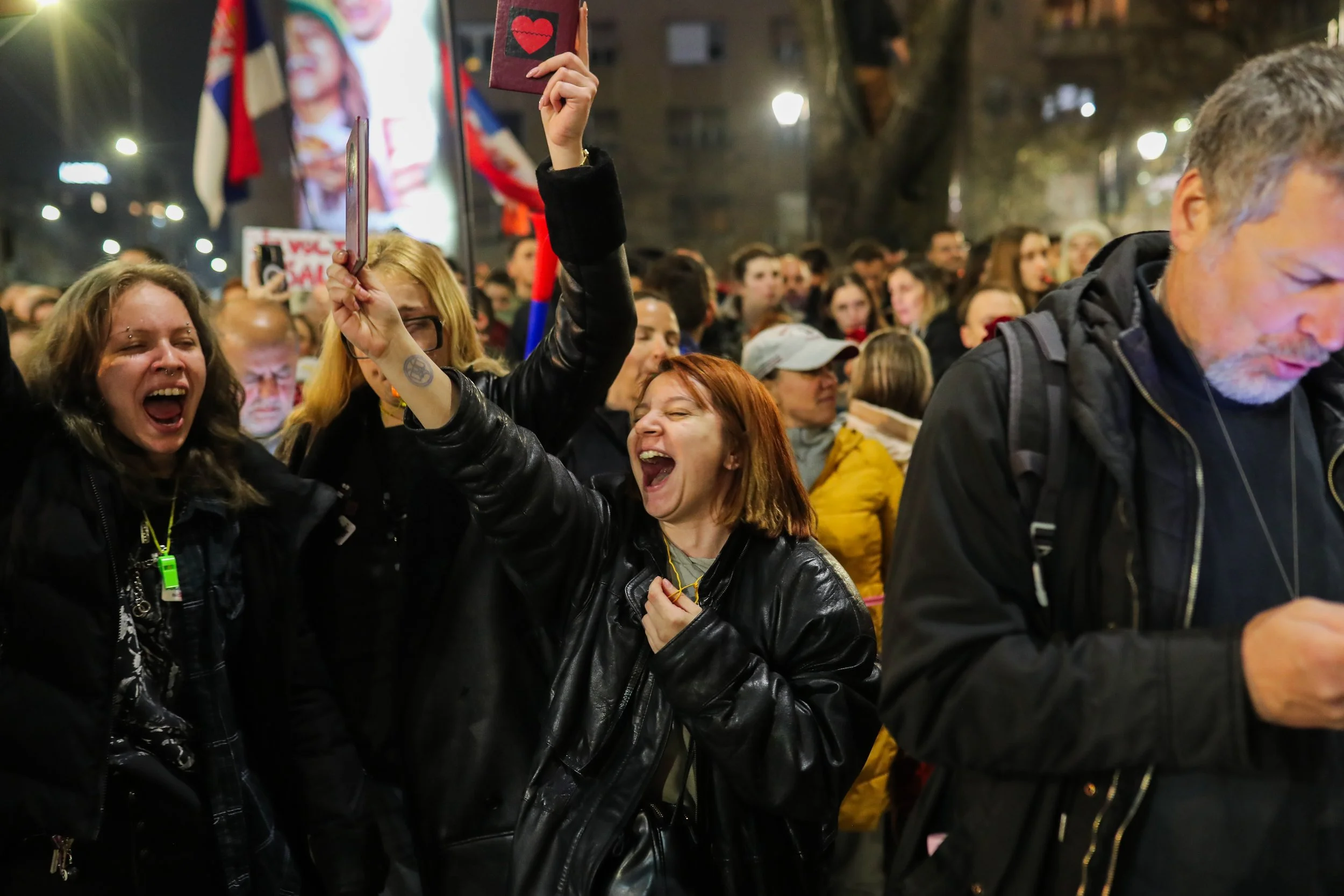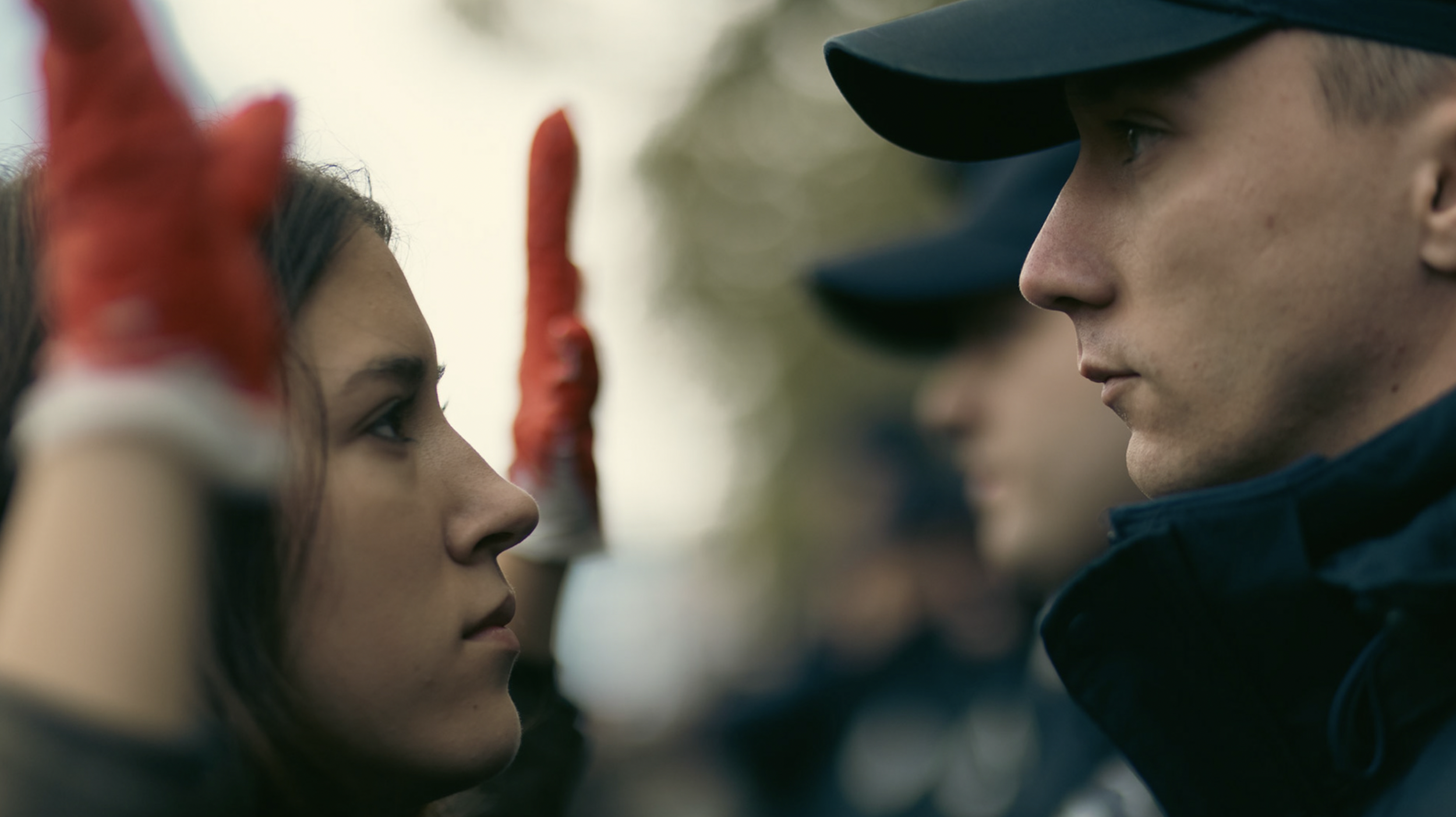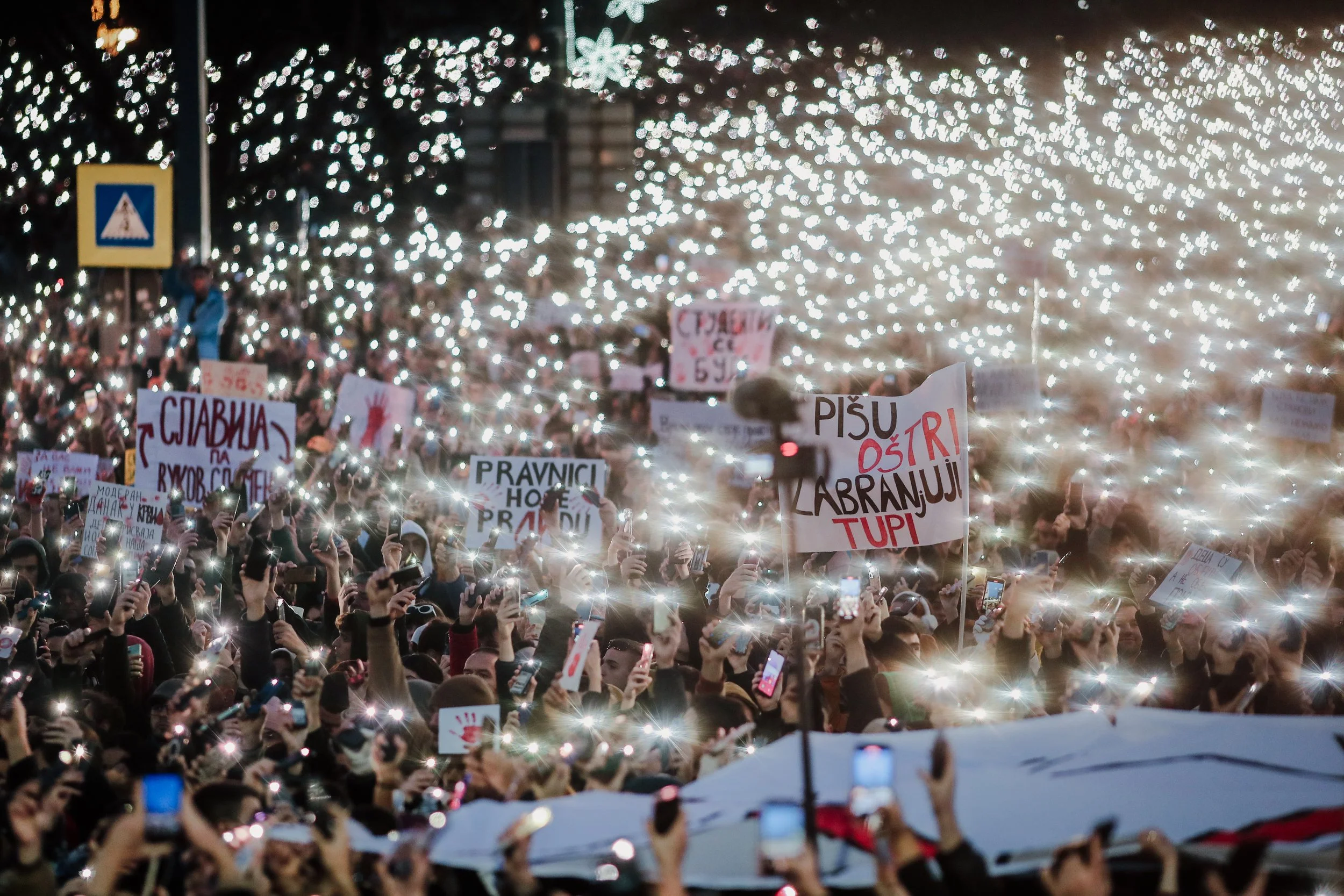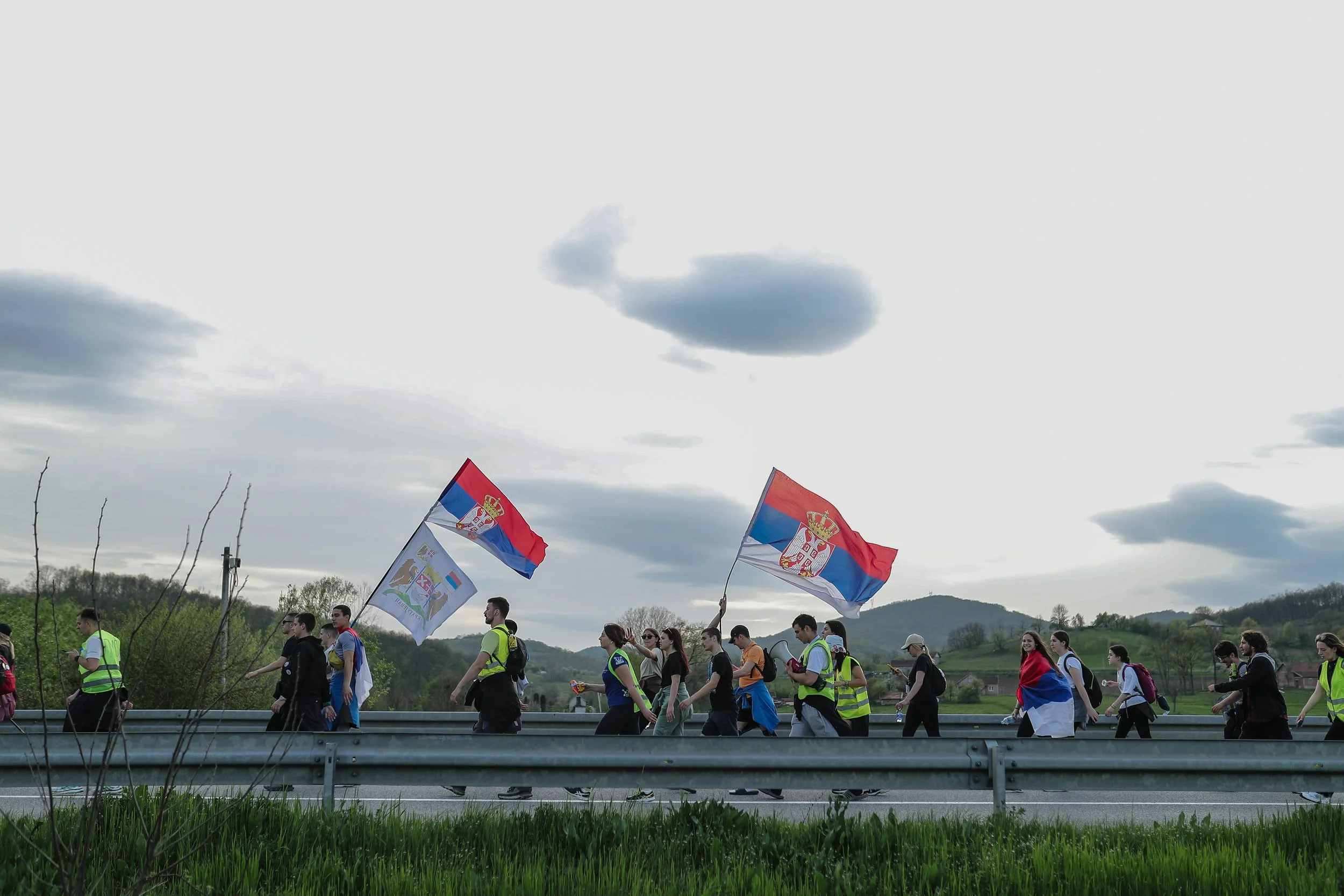A Sea of Stars: Inside Serbia’s Student Movement
That night, January 27th in Belgrade, I had a visceral feeling like I was watching history unfurl in real time. Surrounded by thousands of people chanting, dancing, and calling for change, you forget where your body ends, and another begins. In that shared hum I realized that something had finally punctured through the collective numbness that had settled over Serbia for years. That night, we weren’t just reacting. We were living out a different way of being together.
Photo Credit Lazar Novakovic
The spark for the ongoing Serbian student protest movement came after November 1st, 2024, when a newly renovated railway canopy in Novi Sad collapsed, killing fifteen people – rising to sixteen, after another person succumbed to their injuries. Initially the government denied the canopy was renovated, but documents and photographs proved otherwise, sparking public outrage. This tragedy was far more than a structural failure – it became a stark symbol of the dangers of living in a system where rampant corruption and cronyism run so deep that people feel they can’t even trust the buildings around them to stay standing.
After weeks of zero accountability, university students from the Faculty of Dramatic Arts (FDU) in Belgrade blocked a street and held a silent 15-minute protest – one minute for each life lost. What started as a moment of peaceful mourningquickly escalated when they were assaulted, reportedly by municipal agents. In response, FDU blockaded their university – classes halted, lecture rooms morphed into dormitories and kitchens, and students established a self-governed, democratic occupation.
Although uncertainty swept through the students, they knew what they stood for: a call for accountability and for national institutions to actually do their job.Photo Credit Gavrilo Andric
Photo Credit Gavrilo Andric
This act of resistance rippled outward and seeped into daily life. Today, more than 60 of Serbia’s 80 universities have joined the blockade. Over the last six months, marches have swept the country, government-led media stations blockaded, and at its height, more than half a million people gathered in the capital, marking the largest student-led protest in the region’s history.
This movement is not without precedent – protests against authoritarianism and corruption are deeply rooted in Serbian history. My grandparents lived through the formation of Yugoslavia, only to see it disintegrate decades later in the chaos of civil war. They were among those who took to the streets in the 90s, shouting against the rise of Milošević. My mom continued their march. In a photo from the late 90s, she’s pregnant with me, holding my eight-year-old brother’s hand, protesting against the NATO bombings.
Over the past thirty years, dictators have risen and fallen, borders have shifted, and each promise of a new beginning has eventually crumbled into something painfully familiar. As Pharmacy student, Vera, says, years of eroded trust in the government has made us an ‘anesthetized people, we have accepted the abnormal as normal.’ Over time, this has evolved into a general apathy and a dulled apolitical stance, masking a deeper fear of speaking out.
Until now.
Nadja, a Chemistry student, speaks about witnessing this shift; “People have realized that if you’re silent, you are part of the problem. With the security that comes with a bigger mass, more people have found the courage to stand up. We’ve come to a point where a person sees a group of students and drops everything to help us. This wasn’t our reality six months ago.”
With collective action Big Brother has lost his chokehold of power and people are now occupying the streets demanding for something better.
While speaking with various students in Belgrade I asked them if there was a particular moment in which they also experienced this feeling of witnessing history. Nadja pointed to the December protest at Slavija. “I saw us all here, together, in this silence, under our flashlights, as if we were a sea of stars,” she said. “I realized we’re part of something bigger, morphing into one big organism.”
Photo Credit Lazar Novakovic
From the onset, the silent protests have continued each day. At 11:52 – the moment the canopy fell – the city stops. That night on Slavija, what began on a street corner pulsed in the city’s center.
Over 100,000 people stood in collective silence. No honking, no footsteps – just stillness as Belgrade held its breath.Even as more people join the students, state media continues to cast them as hooligans or worse – foreign mercenaries sent to ruin the country. Vera responds quietly, as if stating the obvious feels heavier than it should: “All those students are someone’s child. The parents know we’re not outsiders – we’re the ones who’ll have to live here tomorrow.”
For Nadja, these protests have unearthed a long-buried reckoning: “The government has long treated the flag and state as personal property,” she says, “but it belongs to everyone. We’re all responsible for the institutions in Serbia.” That night at Slavija, as whistles cut through the silence, her friends raised the Serbian flag into the air – Serbia is ours, not theirs. That, she says, is what we’re fighting for.
Photo Credit Lazar Novakovic
This generation carries a complex inheritance of war and protest, embroiled in past scars misconstruing what it means to be Serbian today. But they are stepping out from that heavy shadow. Law student Jovana reminds us that the fear which once shaped a nation can no longer dictate the present: “I wasn’t there in the nineties, I was born in 2003. We don’t know what it means for bombs to be falling on top of us.” Students are now empowered to demand a different narrative.
This reimagining of collective identity took on a new life as students started walking across the country. What began as a response to the government's quiet sabotage – buses and trains mysteriously "breaking down" mid-route before protests – soon became one of the most powerful forms of connection. These walks were not just about overcoming logistical barriers, but about confronting the media silence that blanketed cities outside Belgrade. As Anna, a Chemistry student, puts it: “You don’t need a TV anymore – just open your window and you’ll see us.” She recalled walking from Belgrade to Niš over four days and 130 kilometers, through rural areas where elderly villagers stood outside their homes clapping and cheering. “When they see that joy – that childlike joy – because to them, we’re still kids, really – it awakens something in them too.”
Photo Credit Lazar Novakovic
Security Studies student, Milica, remembers being greeted by church bells in smaller villages. “With every town we passed, people met us with tears, running into our arms. That was the moment I realized this was bigger than me.” Woven through these long, slow journeys was something unexpected: collective care. A joy so deep it felt almost rebellious.
In a country where silence has long been a survival strategy, now love moved openly – tenderness made public.It appeared not just in crowds and chants, but in seemingly small gestures of care. When Nadja arrived in Niš, the host family stayed up until 1 a.m., grilling sausages and setting out a warm dinner. Anna’s professors worked together to make sure the students were fed, even sending sandwiches to remote mountain stops. After hours of trudging through mud and hills, Milica’s group arrived soaked and exhausted. By morning, their shoes were scrubbed cleaned, clothes folded. “One of the grandmas stayed up all night just for our shoes,” she said, voice breaking. “In those small gestures, you feel how deeply they believe in us.” And maybe that’s the most dangerous thing of all, for those in power to witness that, after everything, we still remember how to feel together.
Photo Credit Danilo Milosevic
Citizens have put so much faith into the students, calling them their saviors, their last string of hope, and I wondered if that pressure takes a toll. But Security Studies student Ana smiled when I asked her, “Well, in a way it’s a lot of pressure, but personally I feel that it’s wind at my back. That’s why we keep going.” The students now face the possibility of failing the year, but their resounding consensus is, “what’s one year compared to what we’re fighting for,” Milica shares.
Questions keep circling around what comes next, but they often miss a crucial point: students alone can’t solve problems rooted so deeply in this country’s foundation. As Milica puts it, “Let everyone build from this energy and start from their own backyard. It’s not just us students – it’s all of us, together." What began as resistance to government oversight, has grown into a living case study in grassroots democracy – no centralized power, one leader, or cult of personality.
Now, instead of pulsing Belgrade streets, I stand in collective silence in front of the Serbian Embassy, surrounded by prim West London buildings and manicured gardens. As I glance around, something strange happens. I see my mother’s nose in a stranger’s profile, my grandfather’s thick fingers in another’s grip, a laugh that feels like it belongs to a cousin I haven’t seen in years. These people, scattered by time and geography, who once would have been just passersby in the diaspora, are now here, every Saturday morning. I see pieces of my own history reflected back in strangers, together choosing, week after week, to keep showing up for the students. This movement is no longer bound to a single place, it lives in gestures, in recognition, in a love that resists forgetting.
Reflecting on the power of collective action in our current political climate brings forward a deeper, more intimate question: what does it really feel like to be here, to be present, entangled in a moment that’s bigger than you, yet made possible because of you? In Serbia, the sight of students embracing strangers after trekking across the country, a passerby gifting their umbrella to a student facilitator caught in the rain, or the quiet gesture of cleaning someone’s muddy shoes as they sleep – all of it reveals how resistance can pulse through the most ordinary acts of care.
But this isn't just about one country. From the streets of Istanbul to the rallies in Yemen, from chants echoing across the US to community kitchens in Gaza, protest has become a language we share – one not bound by borders but by feeling. It spreads through images, rhythms, and memories, each act of courage igniting another. Solidarity today is not always declared in manifestos; often, it’s whispered in DMs, painted on cardboard, or found in the way a crowd holds each other when the police advance. There’s a contagiousness to this kind of action, not just in what we do, but in how we come to imagine ourselves in relation to others.
We begin to realize that what’s happening over there touches something in here. That our struggles are not identical but deeply entangled. And in that entanglement, something potent blooms: a reminder that even in an age of fragmentation, there is still a shared rhythm we can step into together.
Photo Credit Andjela Radojicic








